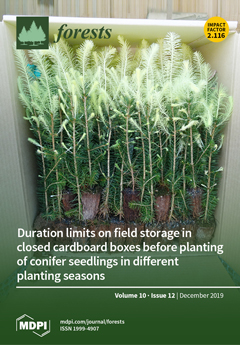Research Highlights: We demonstrate that ectomycorrhizal (ECM) fungi improve plant aluminum (Al)-tolerance in the field and
Laccaria bicolor S238A is a promising ECM isolate. Furthermore, we interpret the underlying nutritional mechanism that ECM inoculation facilitates aboveground biomass production as well as nutrients accumulation
[...] Read more.
Research Highlights: We demonstrate that ectomycorrhizal (ECM) fungi improve plant aluminum (Al)-tolerance in the field and
Laccaria bicolor S238A is a promising ECM isolate. Furthermore, we interpret the underlying nutritional mechanism that ECM inoculation facilitates aboveground biomass production as well as nutrients accumulation and translocation. Background and Objectives: Al toxicity is a primary limiting factor for plants growing in acidic soils. Hydroponic/sand culture studies have shown that some ECM fungi could enhance plant Al-tolerance. However, the underlying mechanisms of ECM fungi in improving plant Al-tolerance in the field are still unknown. To fill this knowledge gap, the present study aimed to examine roles of ECM inoculation in biomass production, accumulation and translocation of nutrients and Al in the host plant grown in the field under Al treatment. Materials and Methods: 4-week-old
Pinus massoniana seedlings were inoculated with three
Laccaria bicolor isolates (
L. bicolor 270,
L. bicolor S238A or
L. bicolor S238N) and grown in an acidic yellow soil under 1.0 mM Al treatment for 12 weeks in the field. Biomass production, accumulation and translocation of P, Ca, Mg, and Al were investigated in these 16-week-old
P. massoniana seedlings.
Results: All three of these
L. bicolor isolates improved biomass production as well as P, Ca and Mg accumulation in
P. massoniana seedlings. Moreover, the three ECM isolates facilitated the translocation of P, Ca, and Mg to aboveground in response to Al treatment, particularly when seedlings were inoculated with
L. bicolor S238A. In addition, both
L. bicolor 270 and
L. bicolor S238A had no apparent effects on Al accumulation, while enhanced Al translocation to aboveground. In contrast,
L. bicolor S238N decreased Al accumulation but had no significant effect on Al translocation.
Conclusions: ECM fungi in the field improved plant Al-resistance by increasing nutrient uptake, and this was mostly due to translocation of P, Ca, and Mg to aboveground, not by decreasing the uptake and translocation of Al.
Full article





